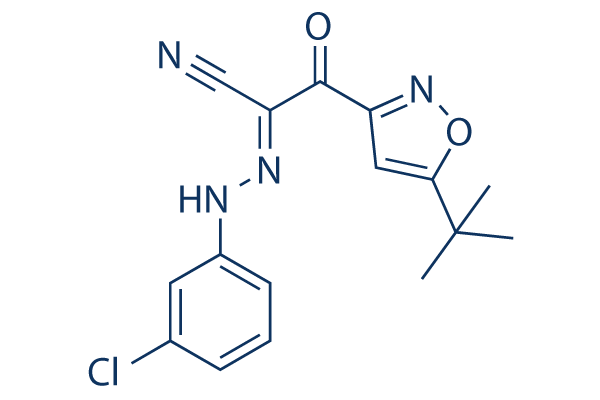| Cas No.: | 263707-16-0 |
| Chemical Name: | (E)-3-(5-tert-butylisoxazol-3-yl)-2-(2-(3-chlorophenyl)hydrazono)-3-oxopropanenitrile |
| Synonyms: | ESI-09,ESI 09,ESI09 |
| SMILES: | O=C(C(=NNC1C=CC=C(Cl)C=1)C#N)C1C=C(C(C)(C)C)ON=1 |
| Formula: | C16H15ClN4O2 |
| M.Wt: | 330.77 |
| Sotrage: | 2 years -20°C Powder, 2 weeks 4°C in DMSO, 6 months -80°C in DMSO |
| Description: | ESI-09 is a novel noncyclic nucleotide EPAC antagonist with IC50 values of 3.2 and 1.4 μM for EPAC1 and EPAC2, respectively. |
| In Vivo: | Treatment with ESI-09 dramatically protects WT mice against R. australis infection with much milder disease manifestations and significantly improves survival[2]. |
| In Vitro: | While cAMP competes with 8-NBD-cAMP binding with an IC50 of 39 µM, ESI-09 shows an increased potency with an apparent IC50 of 10 µM. ESI-09 inhibis cAMP-mediated EPAC2 and EPAC1 GEF activity with an IC50 of 1.4 and 3.2µM, respectively. ESI-09 could fit well into the functional cAMP-binding pocket of EPAC1, establishing favorable hydrophobic and hydrogen bonding interactions with the protein’s active-site residues. ESI-09 inhibits 007-AM-stimulated Akt phosphorylation at T308 and S473 in a dose-dependent manner. ESI-09 inhibits pancreatic cancer cells AsPC-1 and PANC-1 migration. ESI-09 inhibits EPAC1-mediated adhesion of PDA cells on collagen I[1]. Exposure to ESI-09 significantly reduces intracellular and total bacterial counts in HUVECs at 30 min postinfection with 10 multiplicities of infection (MOI) of R. australis compared with similarly infected controls[2]. |

 To enhance service speed and avoid tariff delays, we've opened a US warehouse. All US orders ship directly from our US facility.
To enhance service speed and avoid tariff delays, we've opened a US warehouse. All US orders ship directly from our US facility.




















